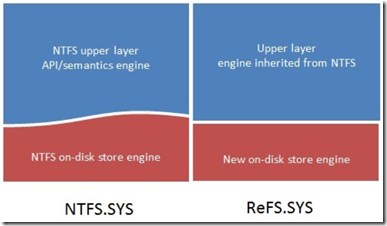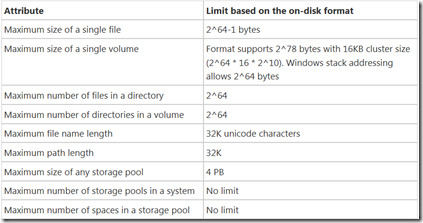Windows 8 to feature new file system
Ron Grattopp ….. This sounded interesting so thought I’d share. Microsoft has announced (via a post on its Building Windows 8 blog) that Windows 8 will introduce a new file system known as Resilient File System (ReFS) which will include a next generation on-disk storage engine. I should assure you upfront that this will not cause major compatibility issues with NTFS although it is a re-plumbing of the FS not just an upgrade to NTFS. The blog says that it’s “a newly engineered file system…built on the foundations of NTFS, so it maintains crucial compatibility while at the same time it has been “architected and engineered for a new generation of storage technologies and scenarios.” Currently plans are for ReFS to make its first appearance as a storage system in Windows Server 8, after which it will evolve into a system for client storage, then ultimately for boot volumes, which is a tried and true paradigm for rolling out new file systems.
….. This sounded interesting so thought I’d share. Microsoft has announced (via a post on its Building Windows 8 blog) that Windows 8 will introduce a new file system known as Resilient File System (ReFS) which will include a next generation on-disk storage engine. I should assure you upfront that this will not cause major compatibility issues with NTFS although it is a re-plumbing of the FS not just an upgrade to NTFS. The blog says that it’s “a newly engineered file system…built on the foundations of NTFS, so it maintains crucial compatibility while at the same time it has been “architected and engineered for a new generation of storage technologies and scenarios.” Currently plans are for ReFS to make its first appearance as a storage system in Windows Server 8, after which it will evolve into a system for client storage, then ultimately for boot volumes, which is a tried and true paradigm for rolling out new file systems.
If you read the technical blog (by Surendra Verma) referenced in the Sinofsky above post you’ll see that we’re doing this to accomplish some key goals that will serve to future-proof the file system. A synopsis of the key goals are:
- Maintaining a high degree of compatibility with a subset of NTFS features that are widely adopted.
- Verifying and auto-correcting data.
- Optimizing for extreme scale
- Never having to take the file system offline.
- Providing a full end-to-end resiliency architecture when used in conjunction with theStorage Spaces feature. (I recommend my technical readers checkout this post on Storage Spaces which will give a more complete view of storage in Windows 8 not just the on-disk engine. For the less technical reader, here’s a quick overview of Storage Spaces, Three Benefits of Windows 8 Storage Spaces)
Cheerio chkdsk .
.
ReFS will inherit some of the key features (and code) of NTFS (i.e. ACLs, BitLocker, symbolic links, etc) but, as mentioned above, it’s essentially a re-plumbing from an architectural point of view – specifically, there will be a new on-disk storage engine as the foundation (see graphic below). If you care, the storage engine will exclusively use something called B+ tree structure to represent stored information. I won’t even attempt a description of what that is but suffice to know that this is not a new thing and it leverages page and tables (like a database) for scalability. Verma indicated this will actually mean a simpler system. He also indicated that the file system is being designed to work for a wide range of devices "from the smallest footprint machines to the largest data centers". To give you an idea of the scalability we’re talking here, ReFS will be able to support file names and file paths with as many as 32,000 characters. It can host files as large as 264 bytes (an exabyte = 260), so this is some serious scalability – I’ve included a screenshot of the capacity specs below as well.


Oh well, this wasn’t intended to be a technical drilldown but rather just an awareness post to highlight this new technology and remind you that, in fact, we are continuing to advance our infrastructure technology to meet future needs, even on things as mundane as file systems.
Cheers, as always,
Ron